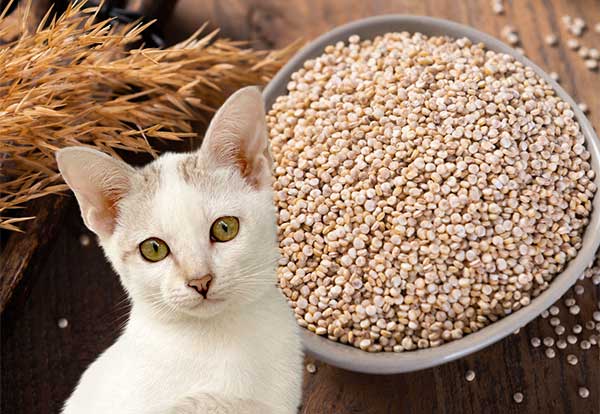Quinoa has grown in popularity over the years, mainly due to its abundance in essential minerals and vitamins.
This grain is incredibly high in dietary fiber, proteins, antioxidants, and a host of other useful nutrients. In fact, many professional nutritionists consider quinoa as a superfood.
But while quinoa promises a truckload of health benefits for humans, does the same apply to cats? Can cats have quinoa?
Yes, cats can safely eat quinoa. Although quinoa is a plant-derived product, many of which have proven dangerous for cats, the grain can offer your feline friend numerous dietary and nutritional benefits.
As we’ve already hinted, quinoa is chockfull of fiber, proteins, antioxidants, and many other minerals and vitamins. These nutrients could benefit cats in nearly the same way they’re useful for humans.
However, there are several precautions to take when feeding quinoa to cats. For instance, quinoa should only be fed to cats in small portions. The grain should never substitute your cat’s regular kibble.
If you’re a fan of quinoa and have been toying with the idea of sharing this food with your kitto, this article is for you. We’ll try to unpack some of the potential benefits of quinoa for cats, highlight a few adverse effects associated with the grain, and suggest the best way to serve quinoa-based foods to your feline companion.
Table of Contents
More About Quinoa
As a quinoa-loving cat owner, it’s not unusual to occasionally find yourself wondering, can my cat eat quinoa?
Cats can definitely eat quinoa. But before we delve deeper into the dos and donts of quinoa for cats, we should probably begin by highlighting where this food comes from.
Quinoa is a pseudocereal closely related botanically to amaranth and spinach. The reason quinoa is called a pseudocereal is that it’s not a real cereal. Rather, it’s technically a seed.
Quinoa grains or seeds come from a herbaceous annual flowering plant of the same name. The plant belongs in the amaranth family and is popularly cultivated as a crop.
The quinoa plant traces its roots to the Andean region of northwestern South America. Archaeological findings indicate that humans consumed the plant as a crop from as far back as 3000 – 4000 years ago, around the Lake Titicaca basin in Peru and Bolivia. Several years later, around 5200 – 7000 years ago, quinoa began to be fed to livestock as fodder.
Despite its origin in South America, quinoa is now cultivated in over 70 countries worldwide. Notable producers include the United States, India, Kenya, and several European countries.
The main reason the spotlight has been shifting to quinoa in the recent past is that the grain not only packs many dietary minerals and vitamins. Its nutritional profile is also higher compared to many grains.
But the question remains, can I give my cat quinoa?
Continue reading for more insights into quinoa and cats.
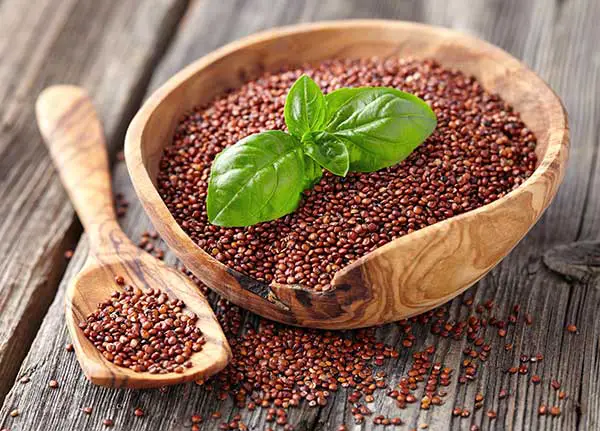
Is Quinoa Good For Cats?
The best way to determine if quinoa is good for cats is to check out the grain’s nutritional profile. Now, a 100-gram serving (3.5 ounces) of cooked quinoa provides the following nutritional elements;
- Energy – 503 kilojoules or 120 kilocalories
- Protein – 4.4 grams
- Carbohydrates – 21.3 grams
- Dietary fiber – 2.8 grams
- Fat – 1.92 grams
- Monounsaturated fat – 0.53 grams
- Polyunsaturated fat – 1.08 grams
- Water – 72 grams
- Vitamin B1 – 0.11 milligrams, representing 9% of the recommended daily value (RDV)
- Vitamin B2 – 0.11 milligrams, representing 9% of the RDV
- Vitamin B3 – 0.41 milligrams, representing 3% of the RDV
- Vitamin B6 – 0.12 milligrams, representing 9% of the RDV
- Vitamin B9 – 42 micrograms, representing 11% of the RDV
- Choline – 23 micrograms, representing 5% of the RDV
- Vitamin E – 0.63 milligrams, representing 4% of the RDV
- Sodium – 7 milligrams, representing 0% of the RDV
- Calcium – 17 milligrams, representing 2% of the RDV
- Potassium – 172 milligrams, representing 4% of the RDV
- Copper – 0.19 milligrams, representing 10% of the RDV
- Zinc – 1.09 milligrams, representing 11% of the RDV
- Iron – 1.49 milligrams, representing 11% of the RDV
- Magnesium – 64 milligrams, representing 18% of the RDV
- Phosphorus – 162 milligrams, representing 22% of the RDV
- Manganese – 0.63 milligrams, representing 30% of the RDV
It’s worth noting that the recommended daily values are based on the human consumption of quinoa. Presently, there’s limited research pointing to quinoa’s direct health and nutritional benefits to cats.
That said, cats will react to quinoa in a near-similar manner as humans. That’s because both species are mammals and share many dietary similarities. Except, of course, the fact that humans are omnivores, whereas cats should be strict carnivores.
- CONTAINS: This pack of Delectables Squeeze Ups contains 32 (0.5 ounce eaches) squeezable cat treat tubes.
- INTERACTIVE TREATING: Squeeze Ups provide the purrfect bonding experience between you and your cat – this playful & interactive...
- PUREE TREATS: Each lickable treat tube is stuffed with a thick and creamy puree treat that is made from real poultry and fish.
Last update on 2024-07-22 / Affiliate links / Images from Amazon Product Advertising API
Is Quinoa Healthy For Cats?
The following are potential health benefits of quinoa for cats;
1. Quinoa Is Rich in Protein
Cats are obligate carnivores. Their diets comprise primarily of animal products.
However, there’s no harm in supplementing your kitto’s regular diet with plant protein. And that’s where vegetables like quinoa come in. Cooked quinoa provides 4.4 grams of protein for every 100-gram serving.
Protein provides amino acid chains which form the building blocks for an animal’s muscles, tissues, and even bones. It’s pretty much what animals require to thrive. A high protein diet can help to strengthen your cat’s bones and tissues, while also boosting the functions of his internal organs.
2. Quinoa May Aid Digestion
Quinoa is rich in dietary fiber. A 100-gram serving of cooked quinoa cereals provides as many as 2.8 grams of fiber. Fiber can aid your cat’s digestion in various ways.
For starters, fiber creates stool-bulking effects. Therefore, it might help to relieve digestive complications like constipation and diarrhea.
That begs the question, can cats eat quinoa for an upset stomach?
Yes, quinoa may help cats battling an upset stomach. That’s because these grains contain fiber, a nutrient known for its ability to combat constipation and stomach upset.
Another way fiber may benefit cats is that it nourishes gut microbiota. Gut microbiota is a term for the healthy microorganisms (especially bacteria) that inhabit an animal’s alimentary canal.
These organisms play a crucial role in food digestion. Besides, they’ve been associated with reduced risks of chronic conditions like inflammatory bowel disease (IBD).
3. Quinoa May Promote Hydration
Cats have a notorious reputation of being fussy eaters. It’s not unusual for a cat that has enjoyed a specific diet nearly his entire life to suddenly lose interest in that diet.
Cats can be picky drinkers too. These animals will drink just alright on some days but inexplicably develop aversions to water on other days.
Fortunately, there are several tips you can follow to get your cat to meet his recommended daily water intake. One such method is by feeding the animal hydrating foods like quinoa.
More than 70% of quinoa comprises water. That’s more than enough to keep your feline friend well hydrated.
Besides, water may work synergistically with fiber to relieve constipation.
4. Quinoa May Support Weight Loss
The combination of dietary fiber, protein, and water can help support weight loss. And the fact that all these nutrients are abundant in quinoa makes the grain remarkably useful for cats dealing with obesity and overweight.
Fiber-, water-, and protein-rich diets can make your cat feel fuller, while also causing the sensations of fullness to last longer. This can help reduce the food portions your kitto consumes in a single meal, while also curbing hunger pangs.
Ultimately, quinoa may help your feline friend lose weight or guard against unhealthy weight gain.
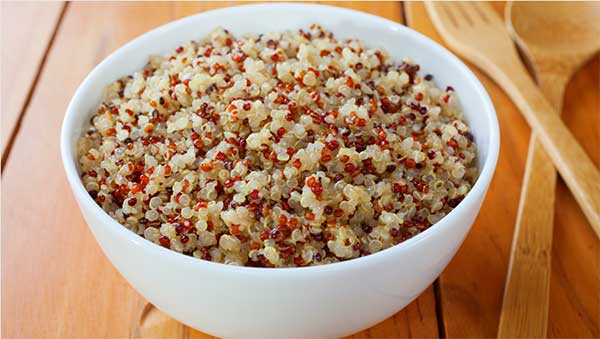
5. Quinoa May Prevent or Treat Diabetes
Not only is dietary fiber useful in aiding digestion, supporting weight loss, and treating constipation. It may also be useful in fighting chronic metabolic diseases like diabetes.
The high fiber content in quinoa can keep your cat’s blood sugar levels in check. That’s because fiber generally moves through the stomach undigested. As a result, it carries with it unhealthy sugars, preventing such compounds from getting to your cat’s bloodstream.
So, can diabetic cats eat quinoa?
Yes, diabetic cats could benefit immensely from quinoa’s positive effects on blood sugar levels.
6. Quinoa May Prevent Seizures and Muscle Spasms
Quinoa packs several minerals and vitamins that can provide antispasmodic effects. One such mineral is magnesium.
Numerous studies have cited magnesium for its ability to relieve seizures and involuntary muscle spasticity.
Magnesium may also combat fatigue, which is a huge problem for cats considering that these animals sleep nearly two-thirds of their time.
7. Quinoa Is High In Antioxidants
Like most grains in the amaranth family, quinoa packs several antioxidants. Antioxidants are compounds that support the immune system by suppressing the negative effects of free radicals in the body.
Feeding your cat antioxidant-rich foods is a proactive way to keep chronic ailments at bay, thereby increase overall mortality.
Common antioxidants in quinoa include the flavonoids like kaempferol and quercetin.
Other quinoa benefits depend on the specific minerals in the grain. For instance, calcium may promote healthy teeth and bone development, while vitamin B9 may help with embryonic development. Besides, quinoa has a mild flavor which many cats may find appealing.
- Number 1 veterinarian-recommended cat probiotic brand to support digestive health (Kantar Veterinary Tracker, 2021), making it an...
- Purina Pro Plan Sensitive stomach cat food supplement for the dietary management of kittens and adult cats with cat diarrhea
- Digestive Care Cat Food supplement containing probiotics proven to promote intestinal health and balance
Last update on 2024-07-22 / Affiliate links / Images from Amazon Product Advertising API
Can Quinoa Make Cats Sick?
Having just highlighted several potential health benefits of quinoa for cats, you may now be feeling motivated to share this grain with your feline friend. But as with any plant-based products, quinoa may prove harmful to your kitto. That’s especially if fed in excess.
For starters, quinoa is relatively high in fiber. Moderate amounts of fiber is good for your cat’s digestion. But too much of it could produce a laxative effect.
That begs the question, does quinoa give cats diarrhea?
Yes, quinoa may give cats diarrhea. If your cat usually gets a runny stomach whenever you feed him quinoa, then it’s likely because you’re giving the animal more than his fair share of the grain.
Weight gain is another possible issue with quinoa for cats. Again, this may sound contradictory since we’ve already highlighted that the grain may actually help to keep your cat’s weight in check.
However, it’s worth noting that quinoa is a high-calorie food. The grain also packs considerable amounts of carbohydrates and fats. This combination could trigger unhealthy weight gain instead of preventing it. But as you may have gathered by now, the chances of your cat packing up extra weight from quinoa will depend on the portions served and the preparation methods used.
Last but not least, there are risks of allergy to beware of. This begs the question, are cats allergic to quinoa?
Quinoa allergies in cats are uncommon. However, the fact that quinoa is a plant-based food and cats are wired to consume animal products means your feline friend could develop allergic reactions to the vegetable.
Quinoa allergy in cats can produce a wide spectrum of symptoms, ranging from gastrointestinal issues like diarrhea to respiratory problems like labored breathing. You can also expect irritability, fever, elevated heart rate, sudden skin changes, etc.
Can Cats Have Uncooked Quinoa?
The decision to feed uncooked quinoa to your cat should be informed by four main considerations – nutritional profile, taste, digestibility, and toxicity.
i. Nutritional Profile
Raw quinoa is definitely more nutritious for cats than cooked quinoa. That’s for the simple reason that cooking is known to destroy many beneficial minerals and vitamins in food.
ii. Taste
Raw quinoa contains a chemical known as saponin. This compound is responsible for the vegetable’s soapy and bitter taste, making uncooked quinoa less attractive for cats.
iii. Digestibility
Not only do the saponins in quinoa come with a bitter taste. Cats also lack the enzymes necessary to break down these compounds. Along with that, uncooked quinoa can be hard for your feline friend to chew.
So, is quinoa easy to digest for cats?
The digestibility of quinoa for cats depends on the serving methods. Uncooked quinoa may prove hard for your cat to digest.
iv. Toxicity
Quinoa contains no known toxins. Which begs the question, is quinoa safe for cats?
Uncooked quinoa is safe for cats to the extent that it doesn’t contain natural toxins. But the grain may harbor pathogens that could make your cat sick. Although washing can decontaminate raw quinoa, it still doesn’t eliminate the risks of further contamination.
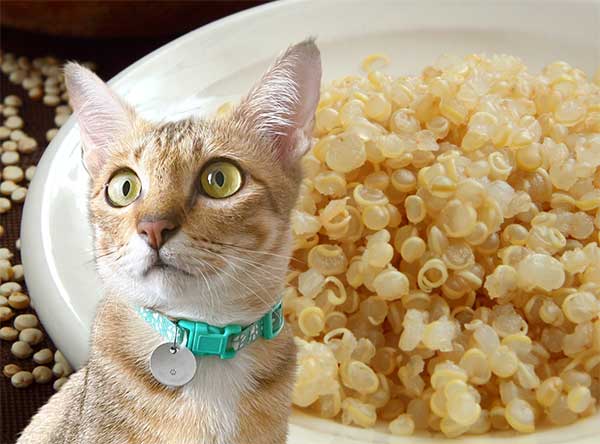
Can Cats Eat Cooked Quinoa?
Not only can cats eat cooked quinoa. But experts actually recommend cooking this vegetable before sharing it with your kitto.
Cooking offers several benefits.
First, it softens quinoa, making the grains easier to chew and digest. Cooking also kills any pathogens and other harmful chemicals that raw quinoa may harbor. Besides, it makes the vegetable yummier and more appealing to cats.
Now, there are several ways to cook quinoa for human consumption. However, not all cooking methods are healthy when it comes to quinoa for cats.
So, how do you cook quinoa for cats?
The best way to cook quinoa for cats is to boil or steam it over moderate heat. You can consider seasoning the grains mildly. Do not use too much fat or salt. In fact, you’re better off cooking the vegetable in plain water.
Excess fat will only induce unhealthy weight gain. On the other hand, salt can lead to sodium ion poisoning, a life-threatening disease that mainly attacks a cat’s kidneys. Symptoms include frequent drinking followed by frequent urination, fever, and appetite changes. If untreated, the disease may trigger other severe symptoms, such as seizures and coma.
It’s also recommended cook quinoa without spices, particularly spices in the Allium family like garlic and onion. Although commonly used to enhance the flavors of human foods, onion and garlic can trigger a severe form of anemia in cats, known as Heinz-body anemia. The disease presents anemia-like symptoms, such as fever, fatigue, and skin paleness.
When ready, you can serve the quinoa to your cat by mixing a few grains into the animal’s regular food.
Can cats eat steamed quinoa?
Yes, cats can eat steamed quinoa. As already indicated, steaming and boiling are the best methods to cook quinoa for cats.
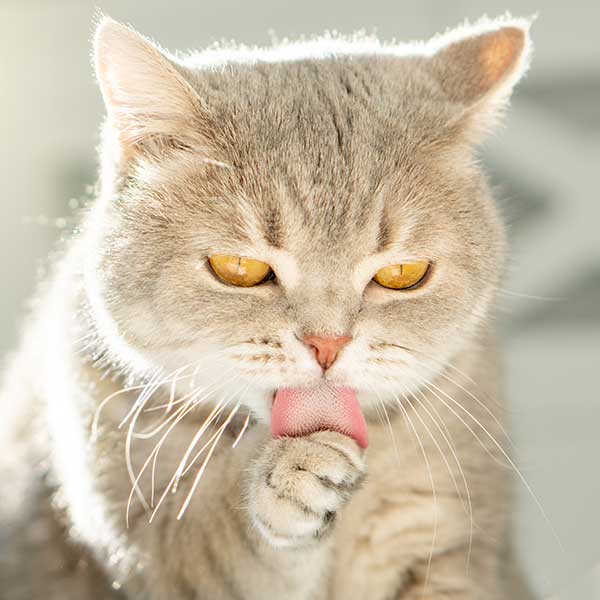
How Much Quinoa Can I Give My Cat?
There’s no hard-and-fast rule to follow in determining the amounts of quinoa to give your cat. That’s because the portions depend on factors like the animal’s age.
Now, that may get you wondering, can kittens eat quinoa?
Kittens can benefit from the health and nutritional properties of quinoa the same way adult cats would. However, due to their sensitive stomachs, kittens may also react more adversely to the side effects of quinoa.
If you must give quinoa to your kittens, do so in moderation. And as already mentioned throughout the article, the rule of moderation applies across the board. Start with two to three quinoa grains or a maximum of one tablespoon for ground quinoa. Then, observe your cat for any adverse effects before increasing the portions.
Other factors that could determine the amount of quinoa to feed your cat include the animal’s body weight, activity levels, and general medical condition.
Having said that, is quinoa good for cats with pancreatitis?
Quinoa cooked in plain water and sparingly served could offer some benefits for cats with pancreatitis, such as relieving constipation. Just be sure to avoid adding too much fat, as fatty foods are known to exacerbate pancreatitis.
Is quinoa good for cats with kidney disease too?
There’s nothing wrong with feeding quinoa to a cat with kidney disease either, provided that the vegetable is free from salt and other ingredients known to worsen the symptoms of kidney disease.
Other Frequently Asked Questions About Cats and Quinoa
Can cats eat black quinoa?
All quinoa varieties are pretty much the same, nutritionally speaking. So, cats can eat black, red, and even white quinoa. And that also helps settle the question – ‘can cats eat red quinoa?’
Can cats have tricolor quinoa?
As we’ve just mentioned, all quinoa varieties will produce more or less similar effects in cats.
Is quinoa flour healthy for cats?
Quinoa flour is healthy for cats as long as it’s fed in moderation.
Can cats eat quinoa bread?
Cats can eat quinoa bread provided that the bread is made from quinoa flour and contains other ingredients known to be non-toxic to cats.
Can cats eat quinoa every day?
Cats shouldn’t eat quinoa every day. The vegetable must be served occasionally and only in small portions.
Is quinoa better than rice for cats?
Quinoa packs more health benefits than rice. However, rice is more effective at combating digestive problems like constipation.
- SmartBlend of high-quality ingredients in the digestive care cat food starts with real salmon along with accents of carrots and...
- High levels of protein in Purina ONE Tender Selects Blend adult dry cat food with salmon help support your cat's strong muscles,...
- Is Purina ONE good for cats? This natural dry cat food with added vitamins, minerals and nutrients and no artificial flavors or...
Last update on 2024-07-22 / Affiliate links / Images from Amazon Product Advertising API
So, Can Cats Eat Vegetable Quinoa?
Yes, quinoa contains numerous nutrients that cats can enjoy. However, this vegetable is only beneficial to cats if cooked with minimal fat and seasoning, then served in small amounts. So, ensure you know how to feed quinoa to your cats before integrating this grain into their diets.
Checkout Our Favorite Cat Products
1. Best Online Course For Cat Parents
Our favorite: The Cat Language Bible (How to Finally Understand And Speak to Your Cat) – A new form of cat to human communication that many cat owners have dreamed about… but few have actually thought possible.
2. Best Immune Support For Cats
Our favorite: Tomlyn Immune Support – Best Supplement for Cats and Kittens.
3. Best Cat Treats
Our favorites: LIFE ESSENTIALS All Natural Freeze Dried Chicken And Sheba Meaty Tender Sticks – Both are Great.

